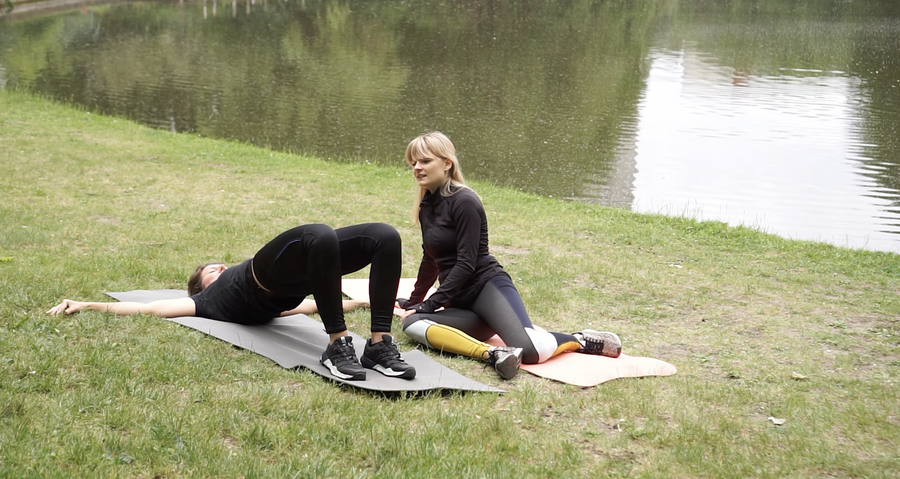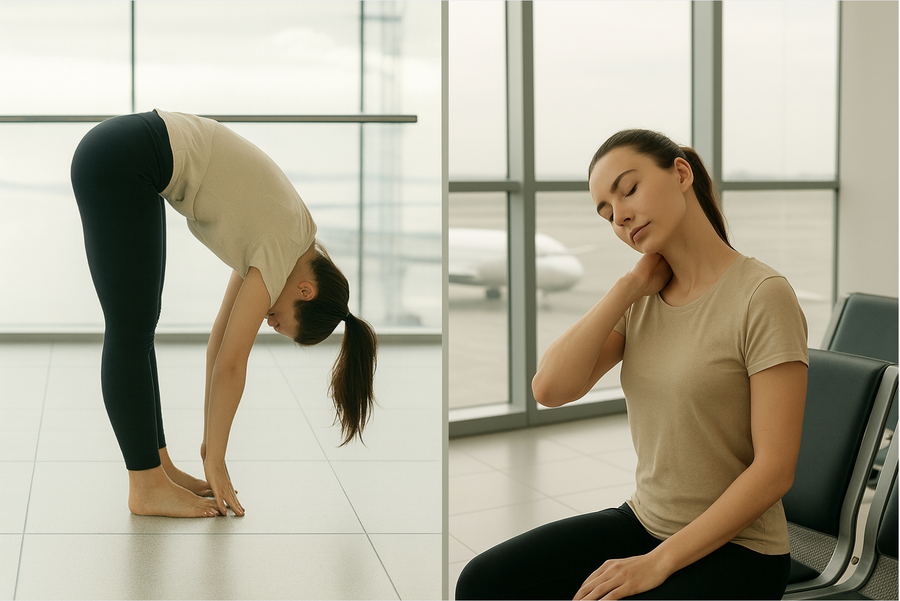If you live on the road or spend days travelling in a van, your yoga practice looks like this: one day you’re flowing on a sandy beach while your mat slides in three different directions, the next you’re trying to balance on a patch of bumpy forest ground. Practicing outdoors is magical, but it definitely comes with its own set of challenges.

Here’s a guide to help you keep your yoga steady, grounded, and enjoyable—no matter whether you’re on sand, gravel, grass, or a sloped little corner of the world.
How to Practice Yoga Outdoors on Uneven Terrain
Uneven ground is simply part of practicing outside and vanlife yoga, and instead of fighting it, you can learn to work with it. Each surface has its own character and will subtly shape your practice—think of it as nature’s way of adding creativity. Let’s explore some common terrains and how to make them work for you:
sand
Soft, shifting, and sometimes delightfully warm. Sand is actually perfect for hip openers, kneeling poses, and slow flows. Balances are a bit trickier. However, I actually enjoy practicing handstands and forearm stands on the beach - I have zero fear of falling.
Place your mat directly on compacted sand if you can (closer to the waterline or the spot where lots of people have walked). Or skip the mat entirely and practice barefoot—the natural instability is great for strengthening your feet and ankles.

gravel and rocky ground
Gravel is the least forgiving surface: it pokes, slides, and somehow always manages to get everywhere. To soften it, place a blanket, towel, or even a jacket beneath your mat. A thicker mat (4–5 mm) will also help keep sharp stones from digging into your knees.
Rocky terrain requires padding. Lots of it. Layer a towel or blanket under your mat, or place your mat on the flattest rock and let the rest of your body spill onto softer ground.
If nothing feels comfortable, skip the mat entirely and opt for a seated meditation—rocks absorb warmth beautifully and can feel surprisingly supportive. Try forward folds here, low-to-the-ground sequences, seated folds, and side stretches, and supine asanas. Not the moment for graceful jump-backs.
sloped terrain
Practicing on a small incline can be surprisingly supportive.
This is a great place for strength-focused flows: warriors, low lunges, crows, twists, and standing forward folds. Let the gravity work for you. Keep transitions slow and steady.
grass full of bumps and roots
Grassy floors are gorgeous, but full of little surprises. To even out bumps, shake the mat out a few times or move it around until you find a relatively flat section. Using a folded towel underneath the “problem area” works wonders.
Here you can do a full flow—sun salutations, gentle backbends, standing poses. Just be mindful :)

sailboat
Yoga while sailing is a beautiful mix of freedom and challenge. I tried flowing on a Bavaria 55, and let’s just say the wind quickly became my unexpected yoga teacher. Every gust tested my balance, every sway of the boat asked for more presence, and every pose had to be anchored from the core. But that’s the magic of it: practicing on deck turns even simple shapes into mindful adventures. With the sea as your soundtrack and endless horizons all around, yoga becomes less about perfection and more about meeting the moment—wind, waves, wobble and all.
How to Stabilize Your Mat on Uneven Ground
• choose heavier mats (they slide less than feather-light travel ones)
• weigh down the corners with rocks or water bottles
• use a towel or blanket under the mat to create a more even surface
• avoid sudden jump transitions (your mat will definitely run away)
• practice low and slow flows when the terrain feels unstable
• remember: sometimes the best "mat" is just the earth itself
When to Skip the Mat
Honestly? Quite often, if you don't need insulation from cold and wet ground. Practicing barefoot on grass, sand, or smooth stone can feel incredibly grounding. For slow practices, meditation, breathwork, or yin-style poses, a mat is optional. A folded blanket or sarong makes a lovely substitute and packs easily into your van.

Must-have Yoga Gear for Vanlife
Your yoga gear should be as flexible and compact as your lifestyle. Here’s what works best on the road:
• foldable or roll mats
If your goal is to save space, consider looking for mats that fold into a square instead of rolling up. They fit easily into drawers or side compartments of your van. However, they tend to get destroyed faster and usually offer worse protection.
• cork vs. rubber for outdoors
Cork: warm, organic, naturally anti-slip, especially when damp.
Rubber: excellent grip, heavier (which is actually an advantage outside), very stable on grass and sand.
If you practice mostly outside, rubber usually wins for stability.
• lightweight blocks or clever alternatives
Foam blocks are great, but if you want to save space: stones, books, water jugs, or even a small travel cooler can substitute perfectly. Vanlife = creativity.
• straps and resistance bands
A strap is tiny but mighty: perfect for deepening stretches after long drives, improving mobility, and doing quick strength sessions. Resistance bands add a whole new dimension to your outdoor practice—especially helpful on uneven terrain where stability is already part of the workout.
• compact meditation cushions
A small foldable or inflatable cushion is a lifesaver if you meditate outdoors. It protects your hips and keeps your spine aligned, even on rocky or sloped ground.

Yoga while traveling in vanlife isn’t about the perfect flat studio floor. It’s about adapting, listening, and letting the landscape be part of your practice. Uneven terrain keeps you present. Changing scenery keeps you inspired. And every patch of earth becomes a place to breathe, stretch, and land in your body again.
